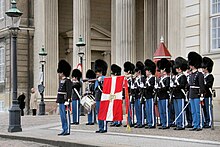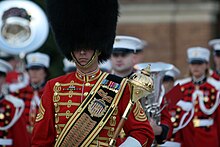Bearskin

A bearskin is a tall fur cap, usually worn as part of a ceremonial military uniform. Traditionally, the bearskin was the headgear of grenadiers and it is still worn by grenadier and guards regiments in various armies.
Origins

The cloth caps worn by the original grenadiers in European armies during the 17th century were frequently trimmed with fur. The practice fell into disuse until the second half of the eighteenth century when grenadiers in the British, Spanish and French armies began wearing high fur hats with cloth tops and, sometimes, ornamental front plates. The purpose appears to have been to add to the apparent height and impressive appearance of these troops both on the parade ground and the battlefield.[1]
During the nineteenth century, the expense of bearskin caps and difficulty of maintaining them in good condition on active service led to this form of headdress becoming generally limited to guardsmen, bands or other units having a ceremonial role. The British Foot Guards and Royal Scots Greys did however wear bearskins in battle during the Crimean War and on peacetime manoeuvers until the introduction of khaki service dress in 1902.[2]
Immediately prior to the outbreak of World War I in 1914, bearskins were still worn by guard or other units in the British, Belgian, Danish, Dutch, Russian and Swedish armies.[3] This did not include use of the busby and other types of smaller fur headdress sometimes confused with the high bearskin. The Italian Sardinian Grenadiers had discarded bearskins in the nineteenth century but were to readopt them for limited ceremonial wear in modern times.
Belgian Army

Until 1914, bearskins were worn in parade uniform by the Régiment des Grenadiers ("Regiment of Grenadiers") of the Belgian Army. [4] Its modern successor unit, the Regiment Carabiniers Prins Boudewijn – Grenadiers has readopted this headdress for limited ceremonial purposes.
The bearskin is also worn by the mounted Royal Escort (see photograph). While this ceremonial unit is now provided by the civilian police, it was formerly part of the now defunct Belgian Gendarmerie and wears the pre-1914 full dress uniform of what was then part of the army.
British Army
Following the Battle of Waterloo and the action in which they gained their name, the Grenadier Guards were permitted to wear the bearskin. In 1831, this practice was extended to the other two regiments of Foot Guards then in existence. The Royal Scots Dragoon Guards, Honourable Artillery Company and officers of Fusilier regiments also wear the bearskin as part of their ceremonial uniform. The bearskin should not be mistaken for the busby which is a much smaller fur cap worn by the Royal Horse Artillery and hussar regiments in full dress. Nor should it be confused with the similar but smaller 'sealskin' cap worn by other ranks of the Royal Fusiliers, actually made of raccoon skin.[5]

The standard bearskin of the British Foot Guards is 18 inches tall, weighs 1.5 pounds and is made from the fur of the Canadian black bear.[6] However, an officer's bearskin is made from the fur of the Canadian brown bear as the female brown bear has thicker, fuller fur and is dyed black. An entire skin is used for each hat.[7] The British Army purchase the hats, which are known as caps, from a British hatmaker which sources its pelts from an international auction. The hatmakers purchase between 50 and 100 black bear skins each year at a cost of about £650 each.[8] If properly maintained, the caps last for decades.
Opposition

On 3 August 1888, The New York Times reported that bearskin caps might be phased out because of a shortage of bear skins. The article stated that, at that time, bearskin hats cost £7–5s each (about 35 contemporary US dollars;[9] £600 in 2007 pounds)[10] and noted “it can readily be seen what a price has to be paid for keeping up a custom which is rather old, it is true, but is practically a useless one save for the purpose of military display”.[11]
In 1997, Minister for Defence Procurement Lord Gilbert said that he wanted to see bearskins phased out as soon as possible due to ethical concerns,[12] but no replacement was available at that time.
In 2005, the Ministry of Defence began a two-year test of artificial fur for the hats. The army has already replaced beaver hats and leopard skins, worn by some of its soldiers, with artificial materials.[13] In March 2005, Labour MP Chris Mullin called for an immediate ban on bearskin hats stating that they "have no military significance and involve unnecessary cruelty."[14]
Animal rights group People for the Ethical Treatment of Animals (PETA) has protested against the continued use of real fur for the guards’ hats, alleging that the animals are killed cruelly. For several years, PETA members have held demonstrations, including one at St. Peter's Hill, near St Paul's Cathedral, in 2006.[15] PETA wants the fur hats to be replaced with synthetic materials and claims that the Ministry of Defence has not done enough to find alternatives. In February 2011, Joss Stone appeared in a PETA advert targeting the Ministry of Defence, showing the 23-year-old soul singer holding a teddy bear that covers her naked body and features the slogan "Bear Hugs, Not Bear Caps".[16]
Army officials say approximately 100 skins are taken every year from the annual cull of thousands of bears by native Inuit hunters in a Canadian government programme to keep numbers under control.[17]
Countries that currently use bearskins



 Belgium: Belgian Federal Police
Belgium: Belgian Federal Police
 Canada: Canadian Forces
Canada: Canadian Forces
- Royal 22e Régiment (1914),[19]
- Governor General's Foot Guards (1872),[20]
- Canadian Grenadier Guards (1859),[21]
- The Royal Regiment of Canada (1862)
 Denmark: Royal Danish Army
Denmark: Royal Danish Army
- Royal Life Guards or Den Kongelige Livgarde (1658)
 Italy: Italian Army
Italy: Italian Army
- 1st Grenadier Regiment Granatieri di Sardegna
- 8th Cavalry Regiment Lancieri di Montebello
 Netherlands: Royal Netherlands Army
Netherlands: Royal Netherlands Army
- The Guard Grenadiers or Grenadiers Garde (1829) - now Garderegiment Grenadiers en Jagers[18]
 Sweden: Swedish Army
Sweden: Swedish Army
- The Royal Life Guards or Kungliga Livgardet (1521)
 United Kingdom:
United Kingdom: British Army
British Army
- The five regiments of Foot Guards
- The Royal Scots Dragoon Guards (Carabiniers & Greys)
- The Honourable Artillery Company
 United States of America:
United States of America: United States Marine Corps
United States Marine Corps
Modern use by military bands

In addition to the specific units named above, bearskins are worn by limited categories of other military personnel with ceremonial functions. These include the band and corps of drums of the British Army's Honourable Artillery Company, the Pipes and Drums of the Royal Scots Dragoon Guards, the band and pioneers of The Royal Regiment of Canada, the band of the Sri Lanka Artillery, and drum majors of the Royal Highland Fusiliers- 2nd Battalion, Royal Regiment of Scotland; United States Marine Band, the United States Army Band, the United States Navy Band, the United States Coast Guard Band, the United States Air Force Band, and the United States Army Field Band. Drum majors of the various service academies, as well as unit, division and fleet bands across the U.S. and worldwide, also frequently use the bearskin in ceremonial missions. Drummers and drum majors of the Pipes and Drums of the 3rd Battalion, Royal Australian Regiment use the bearskin as well.[22][23]
Vatican Gendarmerie
The Papal Corpo della Gendarmeria wore bearskins as part of their ceremonial uniform until this force was disbanded in 1970.
Royal Guards (Thailand)
Most units of the Royal Guards of Thailand wear pith helmets with heavy plumes resembling bearskins with their ceremonial uniforms, especially during the Thai Royal Guards parade held every year in December. The colours of the plumes vary from black to pink and blue, depending on the units of the wearers.
Non-military bands

In the United States, a small number of university bands founded through military means also adorn their drum majors with these headpieces as opposed to their synthetic counterparts. One example being the drum majors of the Purdue University "All-American" Marching Band. One high school band in Bethlehem, Pennsylvania - the Liberty High School (Bethlehem, Pennsylvania) Grenadier Band - boasts more than 80 bearskins that are worn with uniforms copied from those of the Coldstream Guards.
See also
- Busby
- Feather bonnet, which slightly resembles a bearskin.
References
- ^ Military Uniforms of the World: Preben Kannil SBN 71370482 9
- ^ British Military Uniforms From Contemporary Pictures: W.Y.Carman Hamlyn Publishing Group 1968
- ^ "Uniforms of the World": Richard Knotel, ISBN 0-684-16304-7.
- ^ Pages 24-25 "Les Soldats de Leopold Ist et Leopold II": Guy Derie/John Pacco. Published Paul Legrain Bruxelles.
- ^ A Dictionary of Military Uniform: W.Y.Carman ISBN 0-684-15130-8
- ^ "Britain Will Never Part with Bearskin Hats," Associated Press, 9 January 2008.
- ^ Rachel Shields, "They're Changing Hats at Buckingham Palace To Save the Black Bear," The Independent 31 Aug. 2008.
- ^ "People's Daily Online -- British Royal Guards criticized for wearing bearskin hats on Queen's Birthday". people.com.cn. Retrieved 21 January 2015.
- ^ "Measuring Worth - Measures of worth, inflation rates, saving calculator, relative value, worth of a dollar, worth of a pound, purchasing power, gold prices, GDP, history of wages, average wage". measuringworth.org. Retrieved 21 January 2015.
- ^ http://www.measuringworth.com/ukcompare
- ^ "BEARSKIN HATS IN DANGER". nytimes.com. 3 August 1888. Retrieved 21 January 2015.
- ^ Buckingham guards' bearskins face their Waterloo
- ^ "PETA roars over U.K. army's hats - World news - Weird news - NBC News". msnbc.com. Retrieved 21 January 2015.
- ^ Call to ban British royal guards from wearing bearskin hats gains support
- ^ "BBC NEWS - UK - England - Naked demo against bearskin hats". bbc.co.uk. Retrieved 21 January 2015.
- ^ Joss Stone goes nude for a PETA campaign against the use of bear fur for military hats
- ^ Matthew Bayley, "End of the Line for Bearskins," Daily Mail accessed 18 Jan. 2011.
- ^ a b World Uniforms in Colour volume 1—The European Nations: Rinaldo D'Ami ISBN 0-85059-031-0
- ^ Uniform of the Royal 22e Régiment photo
- ^ GGFG – About
- ^ "Canadian Army Bearskins - Maciej Swulinski". swulinski.com. Retrieved 21 January 2015.
- ^ http://www.defence.gov.au/army/AABM/Check_it_out.htm
- ^ http://www.rar.org.au/documents/3RARHistoryCom
